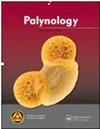巴西属、sedobasia属、spirobasia属和neokosia属(藜科/苋科sensu APG IV)花粉形态的分类意义
IF 1.3
4区 地球科学
Q3 PALEONTOLOGY
引用次数: 0
摘要
摘要根据分子系统发育和形态学研究,在Camphorosmeae部落(藜科/苋科,APG IV)中分别描述了新属Sedobasia Freitag&G.Kadereit和Spirobassia Freitag&G.Kadereet。在分类学中,花粉形态特征经常被用作额外的诊断特征。利用光学显微镜和扫描电子显微镜对欧亚大陆和北美洲巴西利亚属、Sedobassia属、Spirobassia属和Neokochia属13个分类群的26个植物标本的花粉粒进行了乙酰乙酸处理和研究。对干燥花粉粒也进行了研究。本研究首次对花粉小柱的结构进行了分析。本研究的目的是提供关于它们花粉特征的数据,并评估这些数据在属属和种特异性鉴定中的分类学价值。花粉粒全孔,球形,外形圆形,边缘稍波状、波状或直;以及中型或小型。气孔是圆形的,边缘明显或不明显。Exine雕塑是纳米针叶树;盖层psilate或psilate穿孔。纳米针叶树孔膜。讨论了花粉粒最重要特征的分类学相关性(花粉直径、孔隙数量、孔隙直径、孔隙之间和孔隙中心之间的距离、花粉直径(C)/孔隙中心之间距离(D)值、纳米针虫密度、是否有穿孔、小柱结构、孔膜上纳米针虫的数量)。花粉形态被证明是物种特异性鉴定的一个重要的额外信息来源。本研究提供了新的数据,并分析了巴西利亚花粉粒的形态特征(在目前接受的范围内),巴西利亚属、Sedobassia属、Spirobassia属和Neokochia属的花粉形态相似性和分类群之间的差异。本文章由计算机程序翻译,如有差异,请以英文原文为准。
Taxonomic significance of pollen morphology of selected taxa of Bassia, Sedobassia, Spirobassia and Neokochia (Chenopodiaceae/Amaranthaceae sensu APG IV)
Abstract Based on molecular phylogenetic and morphological studies, the new genera Sedobassia Freitag & G. Kadereit and Spirobassia Freitag & G. Kadereit were described in the tribe Camphorosmeae (Chenopodiaceae/Amaranthaceae sensu APG IV). Palynomorphological peculiarities are often used in taxonomy as additional diagnostic features. Pollen grains from 26 herbarium specimens belonging to 13 taxa of Bassia, Sedobassia, Spirobassia and Neokochia genera in Eurasia and North America were acetolyzed and studied using both light microscopy and scanning electron microscopy. Dry pollen grains were also studied. The structure of the columellae of pollen grains was analyzed for the first time in the current study. The aim of this research was to provide data on their pollen characteristics and to evaluate the taxonomic value of these data for generic and species-specific identification. The pollen grains are pantoporate, spheroidal in shape, circular in outline, slightly undulate, undulate or straight on the edges; and medium- or small-sized. Pores are circular, with distinct or indistinct margins. Exine sculpture is nanoechinate; tectum psilate or psilate-perforate. Pore membranes with nanoechini. Taxonomic relevance of the most important characters of pollen grains is discussed (pollen diameter, pore number, pore diameter, distance between pores and between pore centers, pollen diameter(C)/distance between pore centers(D) value, nanoechini density, presenсe/absence of perforations, structure of columellae, number of nanoechini on pore membranes). Pollen morphology proved to be an important additional source of information for species-specific identification. This study provides new data and analyzes the morphological features of pollen grains of Bassia (in the currently accepted circumscription), palynomorphological similarities, and differences between taxa of the genera Bassia, Sedobassia, Spirobassia, and Neokochia.
求助全文
通过发布文献求助,成功后即可免费获取论文全文。
去求助
来源期刊

Palynology
地学-古生物学
CiteScore
3.40
自引率
26.70%
发文量
48
审稿时长
>12 weeks
期刊介绍:
Palynology is an international journal, and covers all aspects of the science. We accept papers on both pre-Quaternary and Quaternary palynology and palaeobotany. Contributions on novel uses of palynology, review articles, book reviews, taxonomic studies and papers on methodology are all actively encouraged.
 求助内容:
求助内容: 应助结果提醒方式:
应助结果提醒方式:


